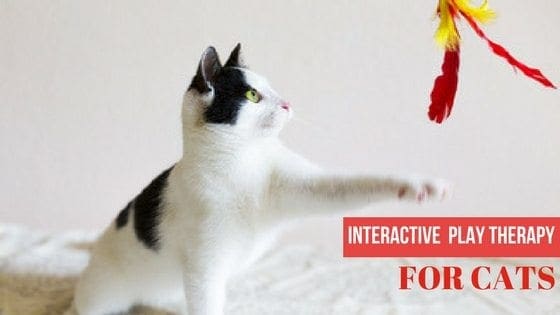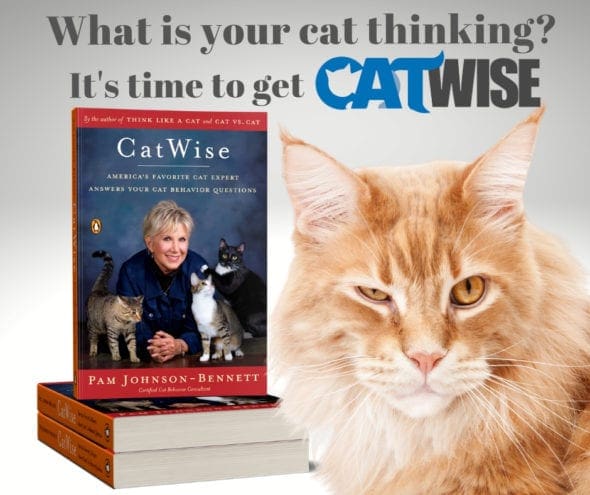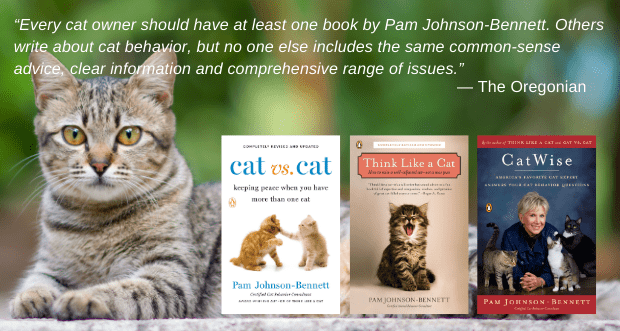
Listen to the audio version of this article
Interactive play is a very powerful tool you can use to help your cat in a variety of situations. It’s great for trust-building, helping two cats become friends, exercise, stress relief, and the list goes on. Even though your cat may be one who is so revved up she can make a game out of playing with the dust bunnies under your furniture, don’t overlook how valuable it is to incorporate interactive playtime into your daily schedule.
You are the key Ingredient
Interactive play involves YOU. The concept is simple. You use a fishing pole-type toy or wand toy to create prey-like action. If you’re going to truly have a think like a cat mentality when it comes to cat behavior, you have to conduct a game that allows your cat to act like the athletic hunter she was born to be. With the interactive toy, you move it so the target at the end of the string can wiggle, slide, dart, and creep around the room. When you move the toy like prey, it’ll stimulate the hunter in your cat.
While you may have lots of toys around the house for your cat, the problem is they’re essentially “dead” prey. They don’t move. The only way to create action is if your cat bats at them. With the interactive toy, however, she doesn’t have to be both predator and prey – she can simply focus on being the hunter.
Match the Toy to Your Cat’s Personality
There are many interactive toys available at your local pet product store and online. Some are very basic – pole, string, toy dangling on the end. Some are more complex. When shopping, try to match the toy to your cat’s personality and play style. If you have a somewhat timid cat, go for a toy that’s more basic and easy for her to conquer. If you have a very confident, athletic cat, you can still go for the basic toy or you can choose something more challenging. Just don’t get an interactive toy that has too big of a target toy on the end because you don’t want it to be become an opponent.
Some cats have toy preferences in terms of size, whether it makes noise, and texture. One cat may prefer a toy that has a soft texture for biting, while another cat may prefer a hard plastic toy that’s easy to swat. Pay attention to any toy preferences you notice with your cat so you can maximize playtime fun.
Scheduling Play
Maintain a regular schedule of interactive play with your cat. It won’t do any good to do a great playtime today and then not do another one for a week. Your cat needs the consistency. Schedule playtime once or twice a day, with about 15 minutes for each session. You’d be surprised what a ½ hour a day of playtime and fun can do for a cat’s emotional and physical health.
All the Right Moves
How you move the interactive toy is important. Don’t wave it around frantically just to give your cat an aerobic workout. That’s not how cats naturally hunt. Stick to what’s natural for your cat. In the wild, a cat would stalk her prey while staying as quiet and invisible as possible. She would inch closer and closer and then, when she gets within striking distance, she would pounce. Cats don’t have the lung capacity to chase to exhaustion so don’t conduct marathons throughout the house. Move the toy like prey, alternating between fast and slow motions so it gives your cat time to plan her next move. Here’s a tip: movements that go away from or across your cat’s visual field will trigger her prey drive. Don’t dangle the toy in her face or move it toward her.
Hunting is just as much mental as it is physical. For interactive playtime to be beneficial for your cat in terms of confidence, trust-building or stress-relieving, she has to be able to plan her moves, have successful captures and not become frustrated. Keep that in mind as you move the toy around. Also, to build confidence, let her have plenty of captures throughout the game. If you were a cat, it would be pretty frustrating if you never got your paws on the toy. Remember the game needs to be fun for your cat.
Ending the Game
When it’s time to end the game don’t just suddenly stop and put the toy away. Your cat may still be very revved up. Instead, wind the action down, in the same way you would do a cool-down after an exercise. Let the prey slowly get tired or injured so the cat’s movements will naturally slow down as well. Then, leave your cat with one final grand capture.
Put Interactive Toys Away
In-between games, store all interactive toys out of your cat’s reach. The most important reason is that you don’t want her to chew on stringed parts. The second reason is you want to keep the toys special.
Not a Replacement for Solo Toys
Interactive toys aren’t a replacement for the many solo toys your cat has around the house. Make sure she has a good supply of the fun little fuzzy mice, puzzle feeders and other toys that are safe to leave around.
Need More Information?
For more information on cat behavior and training, refer to the best-selling books by Pam Johnson-Bennett. Pam’s books are available at bookstores and online. We’ve included links to Amazon here on our website.
If you have a question regarding your cat’s behavior or health, please contact your veterinarian. This article is not intended as a replacement for your cat’s veterinary care. This article is for information purposes only and not offering medical advice or providing a medical diagnosis.
 Problem Solving & Advice by Pam Johnson-Bennett Cat Behavior Expert & Best-selling Author
Problem Solving & Advice by Pam Johnson-Bennett Cat Behavior Expert & Best-selling Author






